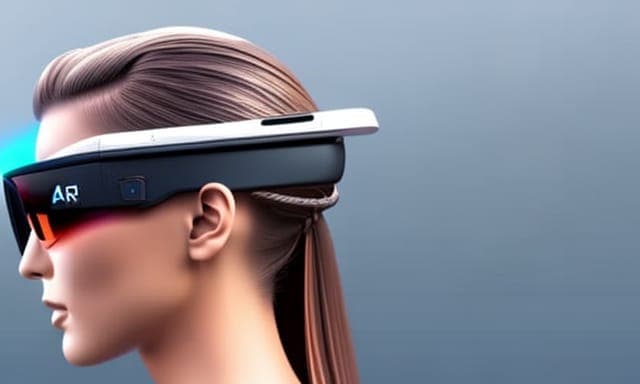Introduction to Smart Glasses and AR
Welcome to the future! Imagine a world where you can access information, get directions, or make a video call without even reaching for your smartphone. That’s the world of smart glasses with augmented reality (AR) capabilities!
Augmented reality is the technology that overlaps digital images and information onto your real-world view. AR smart glasses are wearable devices that blend the physical and digital worlds, enhancing your experiences in ways you’ve never imagined.
In this article, we’ll dive deep into the development of advanced smart glasses, their AR capabilities, and how they’re transforming our lives. We’ll cover everything from their history to the latest innovations, so let’s get started!
History and Evolution of AR Smart Glasses
The Early Days
The journey of AR smart glasses began in the 1960s with the creation of the first head-mounted display (HMD) by Ivan Sutherland. This rudimentary device was the precursor to modern smart glasses. Over the years, various companies and researchers have contributed to the development of this technology.
Modern Innovations
In 2013, Google introduced Google Glass, which gained significant attention as a pioneer in AR smart glasses. Although it faced some setbacks, it paved the way for other companies to explore the potential of AR wearables.
Current State of the Art in AR Smart Glasses
Display Technologies
One of the most critical aspects of AR smart glasses is the display. The waveguide display and micro OLED are popular display technologies offering crisp images, vibrant colors, and seamless AR experiences.
Hardware and Software
Modern smart glasses are equipped with powerful processors, sensors, and cameras that work together to deliver accurate and responsive AR experiences. AR software platforms have also made it easy to develop and deploy AR applications.
Benefits of AR Smart Glasses in Everyday Life
Personal and Entertainment
AR smart glasses have the potential to revolutionize how we consume content, play games, and interact with our environment. Imagine watching your favorite show on a giant virtual screen or having a personal trainer right before you!
Business and Industry Applications
Companies are using AR smart glasses to improve productivity and efficiency. Examples include remote assistance, training, and design visualization.
Healthcare and Accessibility
AR smart glasses can assist people with visual impairments, provide real-time translations, and even help doctors perform surgeries more precisely.
Potential Challenges and Solutions
Privacy Concerns
The integration of cameras and sensors in AR smart glasses raises privacy concerns. Manufacturers must balance functionality and privacy by implementing transparent data policies and user-controlled settings.
Technological Hurdles
Battery life, display quality, and size are some challenges faced by AR smart glasses. Continued innovation in these areas will lead to more advanced, user-friendly devices.
Ethical Considerations
As AR smart glasses become more widespread, we must consider their impacts on society, such as potential job displacement and digital addiction. Open discussions and regulations can help address these issues.
Future of AR Smart Glasses
The future of AR smart glasses is bright, with new advancements in hardware, software, and display technologies. We expect more immersive experiences, seamless integration with other devices, and widespread adoption across industries.
Cutting-Edge Applications of AR Smart Glasses
Education and Training
AR smart glasses are revolutionizing the way we learn and acquire new skills. Teachers can use these devices to provide immersive lessons, making abstract concepts more accessible and engaging. Students can also benefit from personalized learning experiences tailored to their needs and learning styles.
For instance, language learners can get real-time translations of foreign texts, while engineering students can visualize complex structures in 3D. In industries like aviation and manufacturing, AR smart glasses offer hands-on training simulations, allowing workers to practice tasks in a safe environment.
Emergency Services and Disaster Response
AR smart glasses can be invaluable tools for first responders and emergency personnel. Firefighters, for example, can use these devices to access building schematics and locate trapped individuals. Likewise, paramedics can receive vital information about patients’ medical histories and remote guidance from doctors in critical situations.
In disaster response scenarios, AR smart glasses can help rescuers identify safe routes and potential hazards, improving the efficiency and safety of rescue missions. These devices can also provide real-time situational awareness, enabling better coordination among emergency teams.
Customization and Personalization of AR Smart Glasses
Modular and Customizable Designs
As AR smart glasses gain popularity, manufacturers are exploring ways to cater to individual users’ preferences and needs.
Some companies are developing modular designs that allow users to swap out components or upgrade their devices without purchasing an entirely new unit. This not only increases the longevity of the product but also helps reduce electronic waste.
Tailoring AR Experiences
Another aspect of personalization is the ability to customize the AR experience itself. Using AI and machine learning algorithms, AR smart glasses can learn users’ habits, preferences, and interests, providing more relevant and engaging content.
Additionally, developers are creating a wide range of AR applications, ensuring something for everyone, regardless of age, occupation, or interests.
As the market for AR smart glasses grows, we can expect an increasing focus on customization and personalization, making these devices even more versatile and appealing to a broad range of users.
FAQ
- What are AR smart glasses? AR smart glasses are wearable devices that combine the physical and digital worlds, providing augmented reality experiences through overlaying digital images and information onto the real world.
- How do AR smart glasses work? AR smart glasses use display technologies, sensors, cameras, and processors to project digital content onto the user’s field of view, creating an interactive AR experience.
- Are AR smart glasses safe to use? AR smart glasses are generally safe, but users should be aware of potential privacy concerns and responsible when using them in public or around others.
- How much do AR smart glasses cost? The price of AR smart glasses varies depending on features and capabilities, ranging from a few hundred to several thousand dollars.








